Suheng Xu
Graduate research assistant@ Columbia University in the City of New York
Department of Physics, Columbia University
Biography
I’m a PhD candidate in the Physics Department at Columbia University, where I pursue experimental condensed-matter research. My work focuses on imaging quasiparticles and collective excitations in space and time.
-
BSc in Physics
Jilin University, China
-
PhD candidate in Physics
Columbia University, USA
Featured Publications
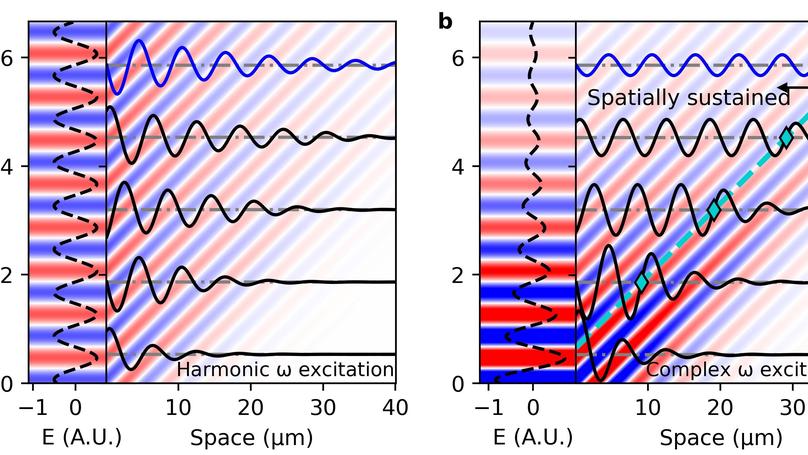
The spatial and temporal dynamics of wave propagation are intertwined. A common manifestation of this duality emerges in the spatial and temporal decay of waves as they propagate through a lossy medium. A complete description of the non-Hermitian wave dynamics, capturing temporal and spatial decays, necessitates the use of complex-valued frequency and/or wavenumber eigen-values. Here, we demonstrate that the propagation of polaritons – hybrid light-matter quasiparticles – can be broadly controlled in space and time by temporally shaping their photonic excitation. Using time-domain terahertz near-field nanoscopy, we study plasmon polaritons in bilayer graphene at sub-picosecond time scales. Suppressed spatial decay of polaritons is implemented by temporally engineering the excitation waveform. Polaritonic space-time metrology data agree with our dynamic model. Through the experimental realization and visualization of polaritonic space-time duality, we uncover the effects of the spatio-temporal engineering of wave dynamics; these are applicable to acoustic, photonic, plasmonic, and electronic systems.
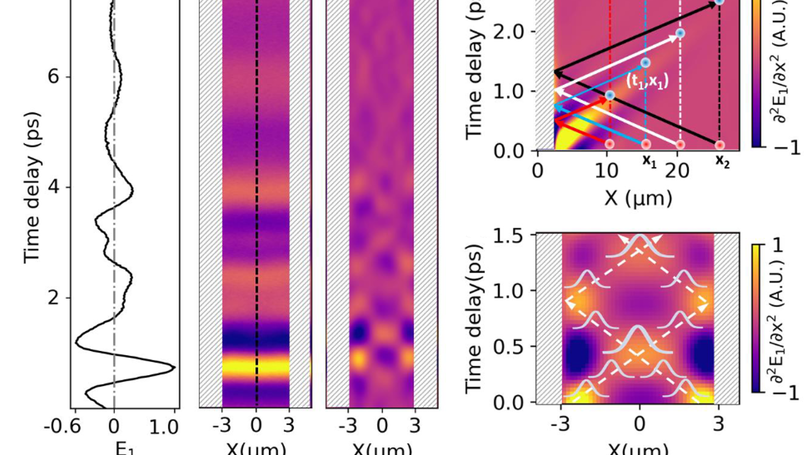
Ultraclean graphene at charge neutrality hosts a quantum critical Dirac fluid of interacting electrons and holes. Interactions profoundly affect the charge dynamics of graphene, which is encoded in the properties of its electron-photon collective modes: surface plasmon polaritons (SPPs). Here, we show that polaritonic interference patterns are particularly well suited to unveil the interactions in Dirac fluids by tracking polaritonic interference in time at temporal scales commensurate with the electronic scattering. Spacetime SPP interference patterns recorded in terahertz (THz) frequency range provided unobstructed readouts of the group velocity and lifetime of polariton that can be directly mapped onto the electronic spectral weight and the relaxation rate. Our data uncovered prominent departures of the electron dynamics from the predictions of the conventional Fermi-liquid theory. The deviations are particularly strong when the densities of electrons and holes are approximately equal. The proposed spacetime imaging methodology can be broadly applied to probe the electrodynamics of quantum materials.
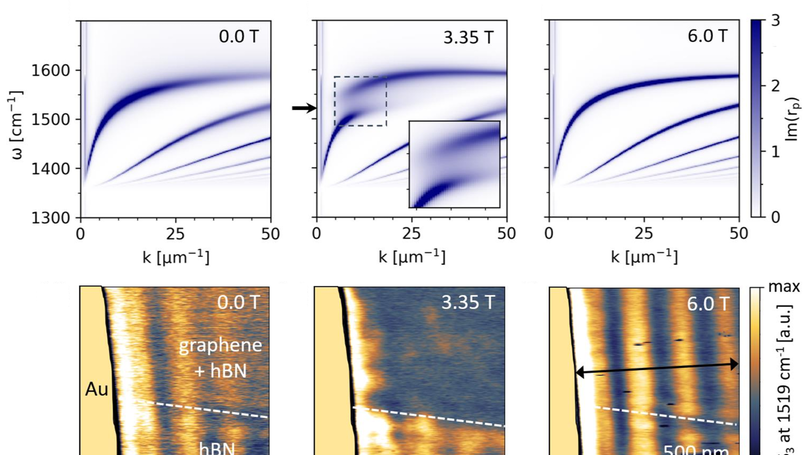
Polaritons are light-matter quasiparticles that govern the optical response of quantum materials and enable their nanophotonic applications. We have studied a new type of polaritons arising in magnetized graphene encapsulated in hexagonal boron nitride (hBN). These polaritons stem from hybridization of Dirac magnetoexciton modes of graphene with waveguide phonon modes of hBN crystals. We refer to these quasiparticles as the Landau-phonon polaritons (LPPs). Using infrared magneto nanoscopy, we imaged LPPs and controlled their real-space propagation by varying the magnetic field. These LLPs have large in-plane momenta and are not bound by the conventional optical selection rules, granting us access to the “forbidden” inter-Landau level transitions (ILTs). We observed avoided crossings in the LPP dispersion - a hallmark of the strong coupling regime - occurring when the magnetoexciton and hBN phonon frequencies matched. Our LPP-based nanoscopy also enabled us to resolve two fundamental many-body effects: the graphene Fermi velocity renormalization and ILT-dependent magnetoexciton binding energies. These results indicate that magnetic-field-tuned Dirac heterostructures are promising platforms for precise nanoscale control and sensing of light-matter interaction.
Recent Publications
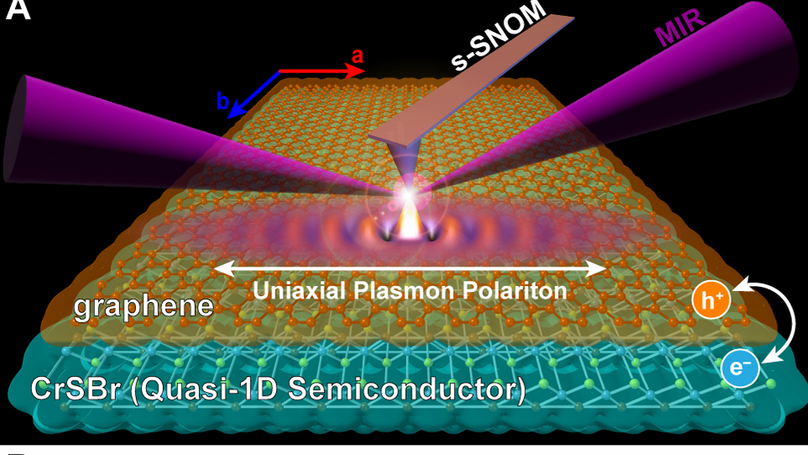
Graphene is a privileged 2D platform for hosting confined light-matter excitations known as surface plasmon-polaritons (SPPs), as it possesses low intrinsic losses with a high degree of optical confinement. However, the inherently isotropic optical properties of graphene limit its ability to guide and focus SPPs, making it less suitable than anisotropic elliptical and hyperbolic materials as a platform for polaritonic lensing and canalization. Here, we present the graphene/CrSBr heterostructure as an engineered 2D interface that hosts highly anisotropic SPP propagation over a wide range of frequencies in the mid-infrared and terahertz. Using a combination of scanning tunneling microscopy (STM), scattering-type scanning near-field optical microscopy (s-SNOM), and first-principles calculations, we demonstrate mutual doping in excess of 1013 cm−2 holes/electrons between the interfacial layers of graphene/CrSBr heterostructures. SPPs in graphene activated by charge transfer interact with charge-induced anisotropic intra- and interband transitions in the interfacial doped CrSBr, leading to preferential SPP propagation along the quasi-1D chains that compose each CrSBr layer. This multifaceted proximity effect both creates SPPs and endows them with anisotropic transport and propagation lengths that differ by an order-of-magnitude between the two in-plane crystallographic axes of CrSBr.
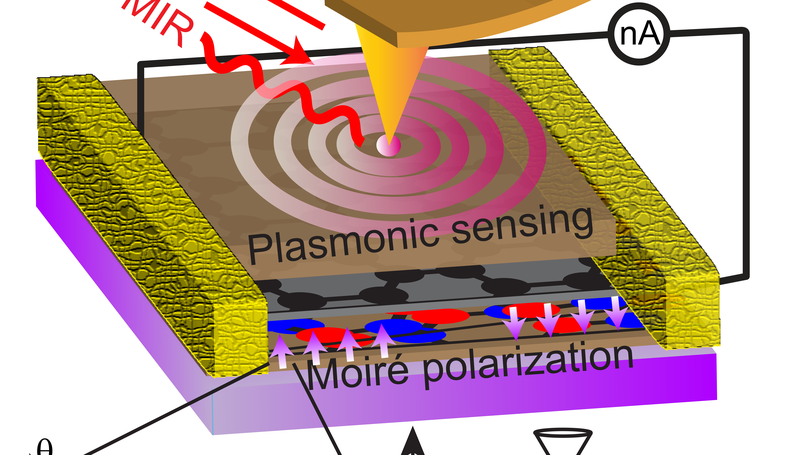
Plasmon polaritons are formed by coupling light with delocalized electrons. The half-light and half-matter nature of plasmon polaritons endows them with unparalleled tunability via a range of parameters, such as dielectric environments and carrier density. Therefore, plasmon polaritons are expected to be tuned when in proximity to polar materials since the carrier density is tuned by an electrostatic potential; conversely, the plasmon polariton response might enable the sensing of polarization. Here, we use infrared nano-imaging and nano-photocurrent measurements to investigate heterostructures composed of graphene and twisted hexagonal boron nitride (t-BN), with alternating polarization in a triangular network of moiré stacking domains. We observe that the carrier density and the corresponding plasmonic response of graphene are modulated by polar domains in t-BN. In addition, we demonstrate that the nanometer-wide domain walls of graphene moirés superlattices, created by the polar domains of t-BN, provide momenta to assist the plasmonic excitations. Furthermore, our studies establish that the plasmon of graphene could function as a delicate sensor for polarization textures. The evolution of polarization textures in t-BN under uniform electric fields is tomographically examined via plasmonic imaging. Strikingly, no noticeable polarization switching is observed under applied electric fields up to 0.23 V/nm, at variance with transport reports. Our nano-images unambiguously reveal that t-BN with triangular domains acts like a ferrielectric, rather than ferroelectric claimed by many previous studies.
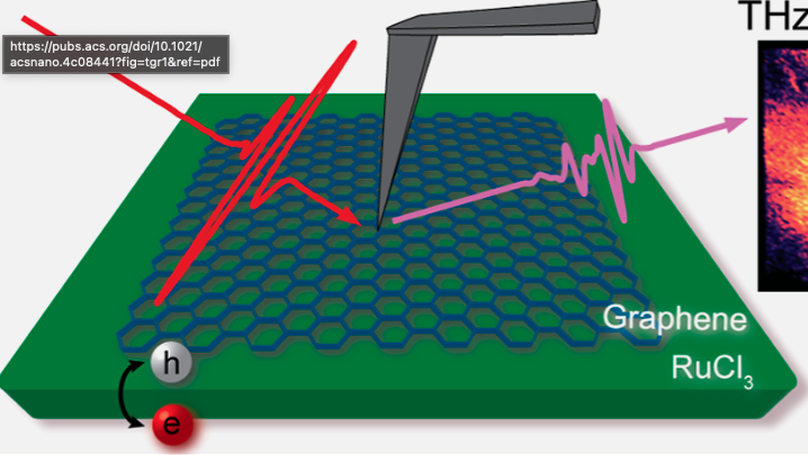
Surface plasmon polaritons (SPPs) provide a window into the nano-optical, electrodynamic response of their host material and its dielectric environment. Graphene/α-RuCl3 serves as an ideal model system for imaging SPPs since the large work function difference between these two layers facilitates charge transfer that hole dopes graphene with n ∼ 1013 cm–2 free carriers. In this work, we study the emergent THz response of graphene/α-RuCl3 heterostructures using our home-built cryogenic scanning near-field optical microscope. Using phase-resolved imaging, we clearly observe long wavelength, heavily damped THz SPPs in a series of variable-size graphene cavities. From this, we extract the plasmonic wavelength and scattering rate in the graphene/α-RuCl3 heterostructures. We determine that the measured plasmon wavelength and electronic scattering rate match our heterostructures’ theoretically predicted values. Our results demonstrate that shaping graphene into bespoke cavity structures enables observation and quantification of SPPs in heavily doped graphene that are largely not addressable with other experimental techniques. Moreover, the manifest lack of metallicity observed in the adjacent doped α-RuCl3 layer provides significant constraints on the nature of the interfacial charge transfer in this 2D heterostructure.
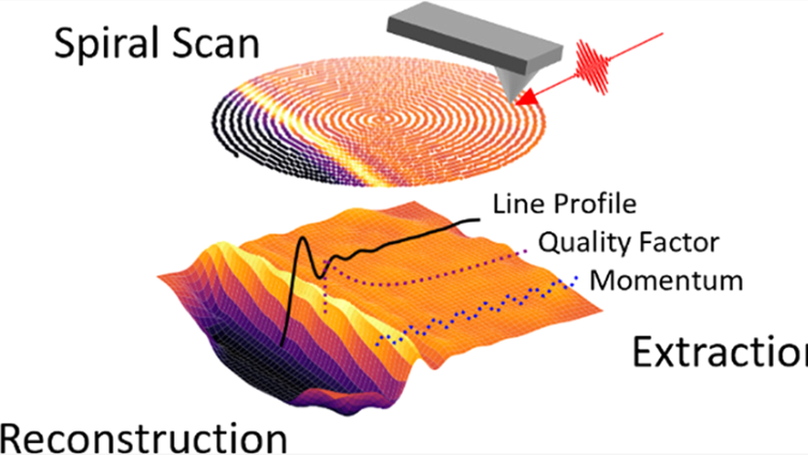
The integration time and signal-to-noise ratio are inextricably linked when performing scanning probe microscopy based on raster scanning. This often yields a large lower bound on the measurement time, for example, in nano-optical imaging experiments performed using a scanning near-field optical microscope (SNOM). Here, we utilize sparse scanning augmented with Gaussian process regression to bypass the time constraint. We apply this approach to image charge-transfer polaritons in graphene residing on ruthenium trichloride (α-RuCl3) and obtain key features such as polariton damping and dispersion. Critically, nano-optical SNOM imaging data obtained via sparse sampling are in good agreement with those extracted from traditional raster scans but require 11 times fewer sampled points. As a result, Gaussian process-aided sparse spiral scans offer a major decrease in scanning time.
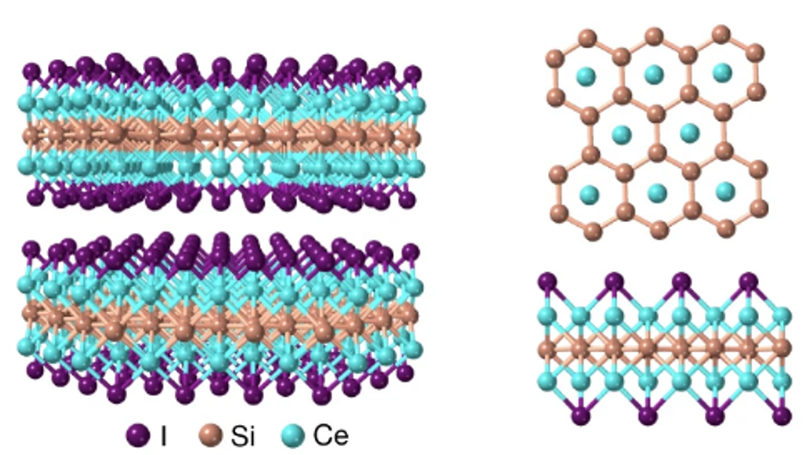
Heavy-fermion metals are prototype systems for observing emergent quantum phases driven by electronic interactions1–6. A long-standing aspiration is the dimensional reduction of these materials to exert control over their quantum phases7–11, which remains a significant challenge because traditional intermetallic heavy-fermion compounds have three-dimensional atomic and electronic structures. Here we report comprehensive thermodynamic and spectroscopic evidence of an antiferromagnetically ordered heavy-fermion ground state in CeSiI, an intermetallic comprising two-dimensional (2D) metallic sheets held together by weak interlayer van der Waals (vdW) interactions. Owing to its vdW nature, CeSiI has a quasi-2D electronic structure, and we can control its physical dimension through exfoliation. The emergence of coherent hybridization of f and conduction electrons at low temperature is supported by the temperature evolution of angle-resolved photoemission and scanning tunnelling spectra near the Fermi level and by heat capacity measurements. Electrical transport measurements on few-layer flakes reveal heavy-fermion behaviour and magnetic order down to the ultra-thin regime. Our work establishes CeSiI and related materials as a unique platform for studying dimensionally confined heavy fermions in bulk crystals and employing 2D device fabrication techniques and vdW heterostructures12 to manipulate the interplay between Kondo screening, magnetic order and proximity effects.
Recent & Upcoming Talks
Contact
- sx2277@columbia.edu
- 888 888 88 88
- 538 WEST 120TH STREET, New York, NY 10463
- Enter Building 1 and take the stairs to Office 200 on Floor 2
-
Monday 10:00 to 13:00
Wednesday 09:00 to 10:00 - Book an appointment
- DM Me
- Skype Me
- Chat on Keybase
- Discuss on Forum

